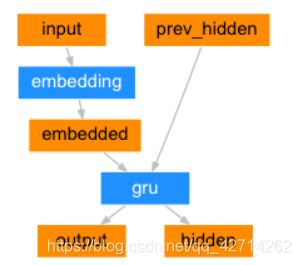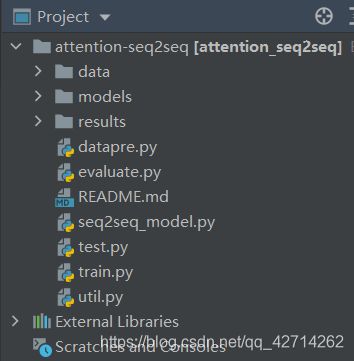基于pytorch的attention-seq2seq实现机器翻译
按照pytorch官网的seq2seq例子整理了一下,使用GRU作为编解码器实现了带注意力的seq2seq模型,代码和数据集已上传到github(已更新,上传了训练好的模型和测试代码),有需自取:https://github.com/JingBob/attention-seq2seq
一、attention seq2seq简介
网上已有很多讲解,这里不仔细展开,具体可参考《全面解析RNN,LSTM,Seq2Seq,Attention注意力机制》。seq2seq模型常用于机器翻译,由两部分组成:encoder和decoder,一般使用RNN网络实现,比较常用的就是LSTM和GRU了。机器翻译时,encoder作用是对输入句子进行特征提取,它的最后一个输出就是从这句话捕获的最后的特征。decoder就利用编码器最后的输出特征解码成目标语言。Seq2Seq模型有一个缺点就是句子太长的话encoder会遗忘,那么decoder接受到的句子特征也就不完全,因此引入attention机制,Decoder每次更新状态的时候都会再看一遍encoder所有状态,还会告诉decoder要更关注哪部分,这样能大大提高翻译精度。具体实现就是不再单纯使用encoder的最后一个状态进行解码,在encoder工作时会保存其每一个输出和隐藏状态,在解码时用于计算当前时刻隐藏状态与编码所有时刻隐藏状态的相关性。
二、GRU简介
相比LSTM,GRU内部少了一个“门控”,参数比LSTM少,因此GRU更容易进行训练,能够很大程度上提高训练效率,结构如下图,具体可参考《人人都能看懂的GRU》。

三、工程实现(法语->英语)
工程是参照pytorch官网的seq2seq案例进行整理的,想了解更多请戳:https://pytorch.org/tutorials/intermediate/seq2seq_translation_tutorial.html,这里主要说一下核心部分:数据集的准备,编解码器的实现和训练过程。整个工程已发布到github:https://github.com/JingBob/attention-seq2seq
我使用的pytorch版本是1.7.1
1.依赖包
from io import open
import unicodedata
import string
import re
import random
import torch
import torch.nn as nn
from torch import optim
import torch.nn.functional as F
2.工程目录
- datapre.py实现了数据的预处理和数据集的准备
- evaluate.py定义了一些评估方法,用于测试
- seq2seq_model.py搭建了encoder和attention decoder,均采用GRU实现
- test.py加载训练好的模型,实现翻译
- train.py顾名思义就是训练脚本
- util.py包含了一些用到的工具函数,如绘图等
3.数据集准备
(1)下载数据集
这里安利一个网站:https://www.manythings.org/anki/,有各种语言的翻译语言对,想做其他语言翻译的可以自行下载,这里我们准备一个英语-法语的数据集,格式如下:
I see. Je comprends.
(2)数据预处理
单词token化,主要是建立word → index的映射。
SOS_token = 0
EOS_token = 1
# 建一个辅助类Lang
# 包含 word → index ( word2index) 和 index → word ( index2word) 字典,以及每个单词的计数word2count,
class Lang:
def __init__(self, name):
self.name = name
self.word2index = {}
self.word2count = {}
self.index2word = {0: "SOS", 1: "EOS"}
self.n_words = 2 # Count SOS and EOS
def addSentence(self, sentence):
for word in sentence.split(' '):
self.addWord(word)
def addWord(self, word):
if word not in self.word2index:
self.word2index[word] = self.n_words
self.word2count[word] = 1
self.index2word[self.n_words] = word
self.n_words += 1
else:
self.word2count[word] += 1
句子预处理一下,单词规定用小写,去掉标点符号等:
# 统一编码为ascii
def unicodeToAscii(s):
return ''.join(
c for c in unicodedata.normalize('NFD', s)
if unicodedata.category(c) != 'Mn'
)
# 统一小写、修剪和删除非字母字符
def normalizeString(s):
s = unicodeToAscii(s.lower().strip())
s = re.sub(r"([.!?])", r" \1", s)
s = re.sub(r"[^a-zA-Z.!?]+", r" ", s)
return s
单词分割,根据空格分割
'''
为了读取数据文件,我们将文件分割成行,然后将行分割成对。
数据集都是英语→其他语言,所以如果我们想从其他语言→英语翻译,添加reverse 标志来反转对。
'''
def readLangs(language1, language2, reverse=False):
print("Reading lines...")
# 分行
lines = open('data/%s-%s.txt' % (language1, language2), encoding='utf-8'). \
read().strip().split('\n')
# 将每行分割成语言对,并正则化
pairs = [[normalizeString(s) for s in l.split('\t')] for l in lines]
# 反转语言对
if reverse:
pairs = [list(reversed(p)) for p in pairs]
input_lang = Lang(language2)
output_lang = Lang(language1)
else:
input_lang = Lang(language1)
output_lang = Lang(language2)
return input_lang, output_lang, pairs
过滤句子
'''
由于有很多例句,要想快速训练一些东西,可以把数据集修剪成只包含相对较短和简单的句子。
代码设定句子的最大长度为 10 个单词(包括结尾标点符号)。
'''
MAX_LENGTH = 10
def filterPair(p):
return len(p[0].split(' ')) < MAX_LENGTH and len(p[1].split(' ')) < MAX_LENGTH
def filterPairs(pairs):
return [pair for pair in pairs if filterPair(pair)]
最后就是定义个函数准备数据啦,完整过程如下:
- 读取文本文件并拆分成行,将行拆分成对
- 标准化文本,按长度和内容过滤
- 从成对的句子制作单词列表
def prepareData(lang1, lang2, reverse=False):
input_lang, output_lang, pairs = readLangs(lang1, lang2, reverse)
print("Read %s sentence pairs" % len(pairs))
pairs = filterPairs(pairs)
print("Trimmed to %s sentence pairs" % len(pairs))
print("Counting words...")
for pair in pairs:
input_lang.addSentence(pair[0])
output_lang.addSentence(pair[1])
print("Counted words:")
print(input_lang.name, input_lang.n_words)
print(output_lang.name, output_lang.n_words)
return input_lang, output_lang, pairs
4.基于GRU的编解码器实现
(1)encoder
seq2seq 网络的编码器是一个 RNN,对于每个输入单词,编码器输出一个词向量和一个隐藏状态,并将隐藏状态用于下一个GRU的输入状态。

class EncoderRNN(nn.Module):
def __init__(self, input_size, hidden_size):
super(EncoderRNN, self).__init__()
self.hidden_size = hidden_size
self.embedding = nn.Embedding(input_size, hidden_size)
self.gru = nn.GRU(hidden_size, hidden_size)
def forward(self, input, hidden):
embedded = self.embedding(input).view(1, 1, -1) # 维度调整为1*1*n
output = embedded
output, hidden = self.gru(output, hidden) # 获取每个GRU的输出和隐藏状态,用于后续计算attention
return output, hidden
def initHidden(self):
return torch.zeros(1, 1, self.hidden_size, device=device)
(2)attention decoder
注意力机制允许解码器针对自身输出的每一步都“关注”编码器输出的不同部分。首先需要计算一组注意力权重,用来乘以编码器输出向量实现加权生成注意力向量。然后将此注意力向量与解码器当前输入进行拼接作为GRU的输入:

网络各层结构打印如下:
AttnDecoderRNN(
(embedding): Embedding(10, 256)
(attn): Linear(in_features=512, out_features=10, bias=True)
(attn_combine): Linear(in_features=512, out_features=256, bias=True)
(dropout): Dropout(p=0.1, inplace=False)
(gru): GRU(256, 256)
(out): Linear(in_features=256, out_features=10, bias=True)
)
class AttnDecoderRNN(nn.Module):
def __init__(self, hidden_size, output_size, dropout_p=0.1, max_length=MAX_LENGTH):
super(AttnDecoderRNN, self).__init__()
self.hidden_size = hidden_size
self.output_size = output_size
self.dropout_p = dropout_p
self.max_length = max_length
self.embedding = nn.Embedding(self.output_size, self.hidden_size)
self.attn = nn.Linear(self.hidden_size * 2, self.max_length) # 全连接层
self.attn_combine = nn.Linear(self.hidden_size * 2, self.hidden_size)
self.dropout = nn.Dropout(self.dropout_p)
self.gru = nn.GRU(self.hidden_size, self.hidden_size)
self.out = nn.Linear(self.hidden_size, self.output_size)
def forward(self, input, hidden, encoder_outputs):
# 先把输入embedding
embedded = self.embedding(input).view(1, 1, -1)
# dropout防止过拟合
embedded = self.dropout(embedded)
# 计算注意力权重
attn_weights = F.softmax(self.attn(torch.cat((embedded[0], hidden[0]), 1)), dim=1)
# 矩阵相乘,用注意力权重乘以编码输出
attn_applied = torch.bmm(attn_weights.unsqueeze(0), encoder_outputs.unsqueeze(0))
# 将输入的embedding层和注意力层拼接,按维数1拼接(横着拼)
output = torch.cat((embedded[0], attn_applied[0]), 1)
# 拼好后加个全连接层然后压缩维度0。
output = self.attn_combine(output).unsqueeze(0)
# 激活函数
output = F.relu(output)
# 输入GRU
output, hidden = self.gru(output, hidden)
output = F.log_softmax(self.out(output[0]), dim=1)
return output, hidden, attn_weights
def initHidden(self):
return torch.zeros(1, 1, self.hidden_size, device=device)
5.训练
(1)准备训练数据
# 获取句子中每个单词的索引,返回的是索引序列
def indexesFromSentence(lang, sentence):
return [lang.word2index[word] for word in sentence.split(' ')]
# 根据索引序列建立张量
def tensorFromSentence(lang, sentence):
indexes = indexesFromSentence(lang, sentence)
indexes.append(EOS_token)
return torch.tensor(indexes, dtype=torch.long, device=device).view(-1, 1)
# 输入张量是输入句子中单词的索引,输出张量是目标句子中单词的索引
def tensorsFromPair(pair):
input_tensor = tensorFromSentence(input_lang, pair[0])
target_tensor = tensorFromSentence(output_lang, pair[1])
return (input_tensor, target_tensor)
(2)模型训练
teacher_forcing_ratio = 0.5
'''
为了训练,我们通过编码器运行输入句子,并跟踪每个输出和最新的隐藏状态。
然后解码器被赋予令牌作为它的第一个输入,编码器的最后一个隐藏状态作为它的第一个隐藏状态。
'''
def train(input_tensor, target_tensor, encoder, decoder, encoder_optimizer, decoder_optimizer, criterion,
max_length=MAX_LENGTH):
encoder_hidden = encoder.initHidden()
encoder_optimizer.zero_grad()
decoder_optimizer.zero_grad()
input_length = input_tensor.size(0)
target_length = target_tensor.size(0)
encoder_outputs = torch.zeros(max_length, encoder.hidden_size, device=device)
loss = 0
# 获取编码器的每个输出和隐藏状态,用于计算注意力权重
for ei in range(input_length):
encoder_output, encoder_hidden = encoder(
input_tensor[ei], encoder_hidden)
encoder_outputs[ei] = encoder_output[0, 0]
decoder_input = torch.tensor([[SOS_token]], device=device)
# 解码器第一个隐藏状态是编码器输出的隐藏状态
decoder_hidden = encoder_hidden
# 训练可以使用“Teacher forcing”策略:使用真实目标输出作为下一个输入,而不是使用解码器的猜测作为下一个输入。
# 使用Teacher forcing会使模型收敛更快,但使用训练得到的网络时,可能会表现出不稳定。
use_teacher_forcing = True if random.random() < teacher_forcing_ratio else False
if use_teacher_forcing:
# 将目标单词作为下一个解码输入
for di in range(target_length):
decoder_output, decoder_hidden, decoder_attention = decoder(
decoder_input, decoder_hidden, encoder_outputs)
loss += criterion(decoder_output, target_tensor[di])
decoder_input = target_tensor[di] # Teacher forcing
else:
# 用预测结果作为下一个解码输入
for di in range(target_length):
decoder_output, decoder_hidden, decoder_attention = decoder(
decoder_input, decoder_hidden, encoder_outputs)
topv, topi = decoder_output.topk(1)
decoder_input = topi.squeeze().detach() # detach from history as input
loss += criterion(decoder_output, target_tensor[di])
# 遇到终止符号就退出解码
if decoder_input.item() == EOS_token:
break
# 反向传播
loss.backward()
encoder_optimizer.step()
decoder_optimizer.step()
return loss.item() / target_length
(3)训练过程
- 启动计时器
- 初始化优化器和标准
- 创建一组训练对
- 开始绘制损失函数
'''
@函数名:迭代训练
@参数说明:
encoder:编码器
decoder:解码器
n_iters:训练迭代次数
print_every:多少代输出一次训练信息
plot_every:多少代绘制一下图
learning_rate:学习率
'''
def trainIters(encoder, decoder, n_iters, print_every=1000, plot_every=100, learning_rate=0.01):
start = time.time()
plot_losses = []
print_loss_total = 0 # Reset every print_every
plot_loss_total = 0 # Reset every plot_every
# 优化器用SGD
encoder_optimizer = optim.SGD(encoder.parameters(), lr=learning_rate)
decoder_optimizer = optim.SGD(decoder.parameters(), lr=learning_rate)
training_pairs = [tensorsFromPair(random.choice(pairs))
for i in range(n_iters)]
# 因为模型的输出已经进行了log和softmax,因此这里损失韩式只用NLL,三者结合起来就算二元交叉熵损失
criterion = nn.NLLLoss()
for iter in range(1, n_iters + 1):
training_pair = training_pairs[iter - 1]
input_tensor = training_pair[0]
target_tensor = training_pair[1]
loss = train(input_tensor, target_tensor, encoder,
decoder, encoder_optimizer, decoder_optimizer, criterion)
print_loss_total += loss
plot_loss_total += loss
if iter % print_every == 0:
print_loss_avg = print_loss_total / print_every
print_loss_total = 0
print('epoch:%d %s (%d%%) loss:%.4f' % (iter, timeSince(start, iter / n_iters),
iter / n_iters * 100, print_loss_avg))
if iter % plot_every == 0:
plot_loss_avg = plot_loss_total / plot_every
plot_losses.append(plot_loss_avg)
plot_loss_total = 0
showPlot(plot_losses)
参考文献
[1]全面解析RNN,LSTM,Seq2Seq,Attention注意力机制:https://zhuanlan.zhihu.com/p/135970560
[2]人人都能看懂的GRU:https://zhuanlan.zhihu.com/p/32481747
[3]https://pytorch.org/tutorials/intermediate/seq2seq_translation_tutorial.html
